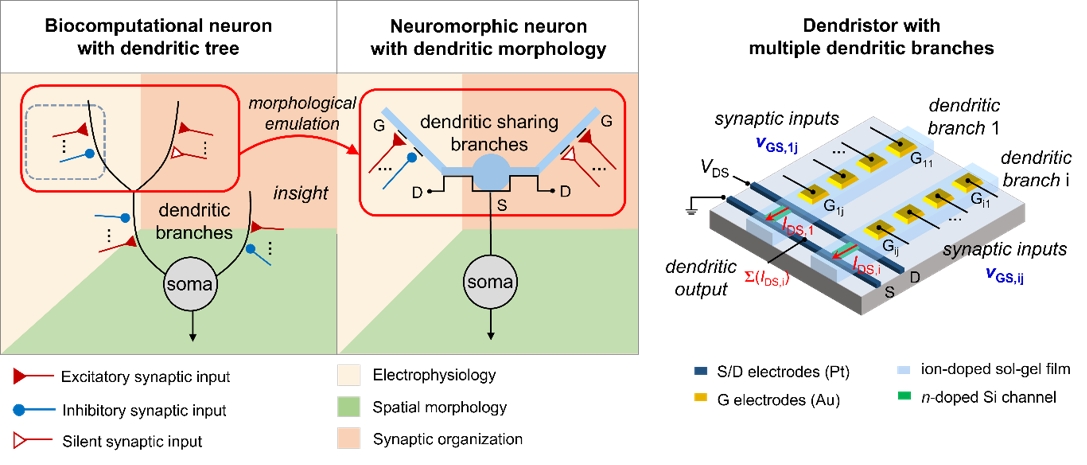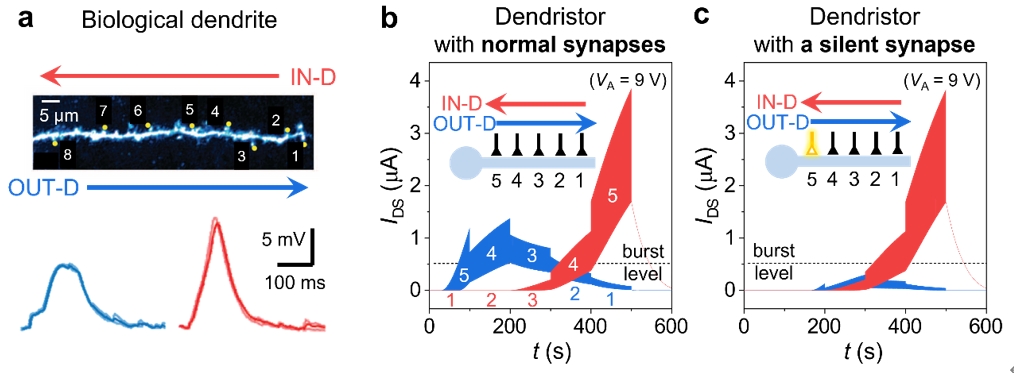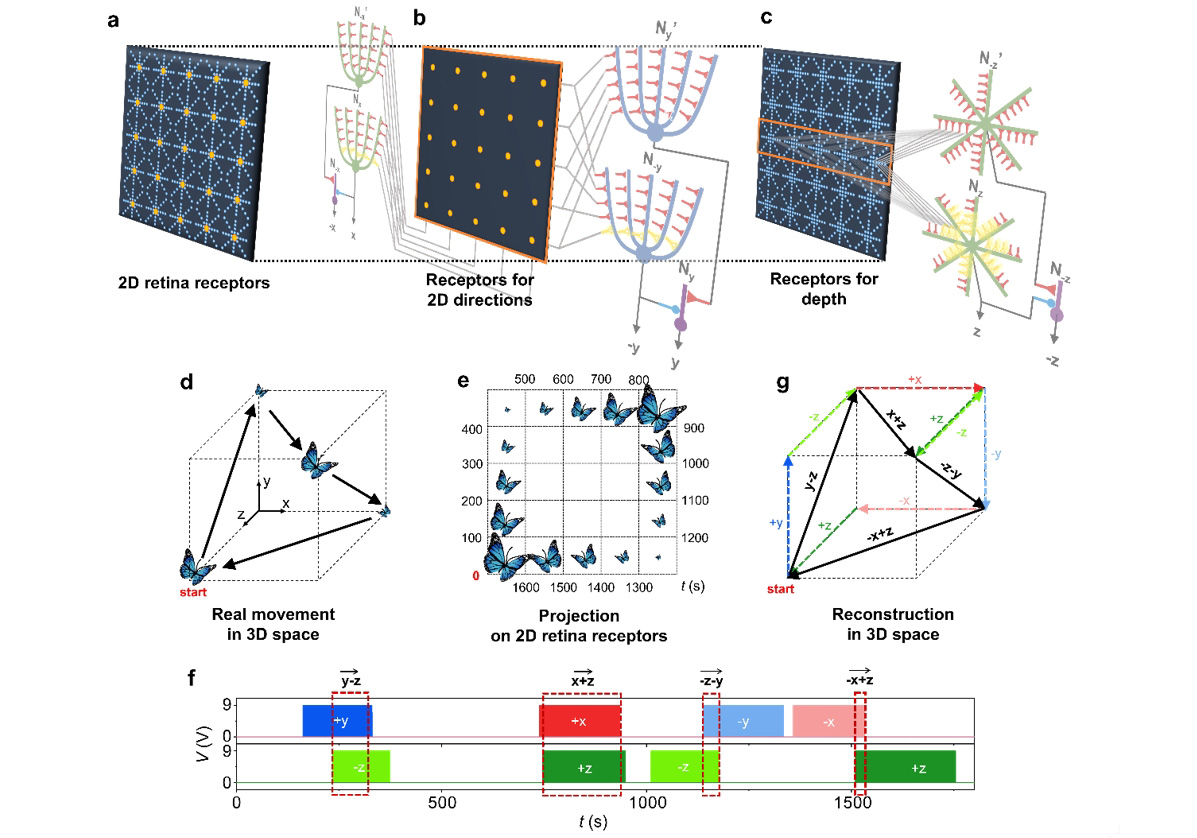An interdisciplinary team of Tsinghua scientists in brain-inspired AI created a neuromorphic dendritic network computation model able to perform energy-efficient visual machine perception. The article recently published in Nature Electronics titled on “Neuromorphic dendritic network computation with silent synapses for visual motion perception”, indroduces a neuromorphic computational model, dendristor, based on multi-gate silicon nanowire transistors. The dendristor can perform dendritic computation by integrating synaptic organization with dendritic tree-like morphology and can be used as a computing unit to develop a multilayer neural network system that emulates three-dimensional spatial motion perception in the retina.
Visual perception is a human brain’s complex intelligent functionalities, emulating it in a neuromorphic device is an important achievement within artificial intelligence (AI) systems. A network of dendristors closely mimics the signal processing exchange in biological dendrites across different neurons, exploiting the unique properties of multi-gate dendritic transistor devices. The dendristor model includes segmented dendritic branch morphology and nonlinear signal integration, thereby enabling branch-specific plasticity across different branches and between neurons. Such advancements highlight the dendristor's potential to serve alone or in a network as a computational model capable of sensory operations and complex cognitive functions.

Figure 1. The dendristor mimicking dendritic tree-like morphology
The dendristor mimics the tree-like structure of dendrites, enabling the nonlinear integration of synaptic input signals along the dendritic branches, which are featured characters of dendritic computation. This model offers branch-specific plasticity, which can improve learning efficiency within sparse neural networks.
This study focuses on the dendristor's intrinsic spatiotemporal plasticity, highlighted by its direction selectivity. Unlike the conventional point-neuron model that relies on synaptic plasticity, the dendristor encodes the spatiotemporal sequence of inputs, generating outputs based on the direction of signal arrivals. This feature is further refined by the inclusion of silent synapses (NMDA-only synapses) activated not only by the inputs but also the dendritic branch potential, which play a pivotal role in enhancing direction selectivity by diminishing insignificant signals.

Figure 2. Direction selectivity comparison between (a) biological dendrite and the Dendristor with (b) normal synapses and (c) a silent synanpse
The expansion of direction selectivity from a single dendristor branch to neuromorphic dendritic neural circuits (NDNCs) represents a significant leap towards executing intelligent processes beyond the capability of single-branch dendritic computation. These circuits utilize dendritic network computation to process inputs not in batches, as seen in conventional artificial neural networks, but rather through branch-by-branch mapping and inhibitory integration.
The NDNC network is expanded to detect movement in 3D space, emulating the visual perception of the brain. This brain-inspired working model combines the network layers detecting movement across 2D binary directions and depth. This study elucidates the relationship between neuromorphic system connectivity and the emergence of intelligent functions, emphasizing the network's scaling from simple directional selectivity to complex 3D motion perception.

Figure 3. Three-dimensional visual motion perception of (a) a multi-layer network of dendritic neural circuits, which integrate (b) two-dimensional direction (x-y) and (c) depth (z) detection circuits. This network processes (d) real movement in 3D space, which is (e) projected onto the 2D retinal receptor and then (f) processed by the multi-layer retinal detection system. (g) The detected directional signals can be reconstructed to resemble brain perception, illustrating how the brain represents the real-world.
The model's event-based approach to processing signals from retina-like receptors, coupled with its relatively modest energy requirements, offers an advantage over traditional GPU-based visual processing systems. This efficiency represents a substantial advancement towards realizing biocompatible and energy-efficient neuromorphic computing systems.
This work marks a significant milestone in the field of neuromorphic computing. By integrating the physics of dendritic transistor devices with computational and network neuroscience, new pathways are unlocked for the development of brain-like network-based perception systems. Those systems hold potential for advanced applications in robotics, autonomous driving, and interactive systems where understanding dynamic environments is crucial.
The development of a neuromorphic dendritic network computation model using dendristors was carried out by a multidisciplinary team. Dr. Eunhye Baek from the Department of Precision Instrument and the Tsinghua Laboratory of Brain and Intelligence (THBI), Tsinghua University; Prof. Rong Zhao and Prof. Luping Shi from the Department of Precision Instrument, Tsinghua University; Prof. Sen Song from Tsinghua Laboratory of Brain and Intelligence (THBI) and School of Biomedical Engineering, Tsinghua University; and, Prof. Carlo Vittorio Cannistraci from the Center of Complex Network Intelligence at the Tsinghua Laboratory of Brain and Intelligence (THBI), Department of Computer Science and School of Biomedical Engineering, Tsinghua University. Prof Chang-Ki Baek from POSTECH in Korea also contributed to this work. Dr. Eunhye Baek, Prof. Luping Shi and Prof. Carlo Vittorio Cannistraci are the co-corresponding authors of this paper.
This research was funded by grants from the National Nature Science Foundation of China, STI2030-Major Projects and various grants from Tsinghua University, including the Guoqiang Institute, the Zhou Yahui Chair Professorship Award, and the starting funding of the Tsinghua Laboratory of Brain and Intelligence. It also received support from the National High-Level Talent Program of the Ministry of Science and Technology of China.
Publication
“Neuromorphic dendritic network computation with silent synapses for visual motion perception”
Authors: Eunhye Baek*, Sen Song, Chang-Ki Baek, Zhao Rong, Luping Shi* and Carlo Vittorio Cannistraci*
Nature Electronics, June 06, 2024
https://www.nature.com/articles/s41928-024-01171-7
From Tsinghua Laboratory of Brain and Intelligence (THBI)
Editor: Li Han

